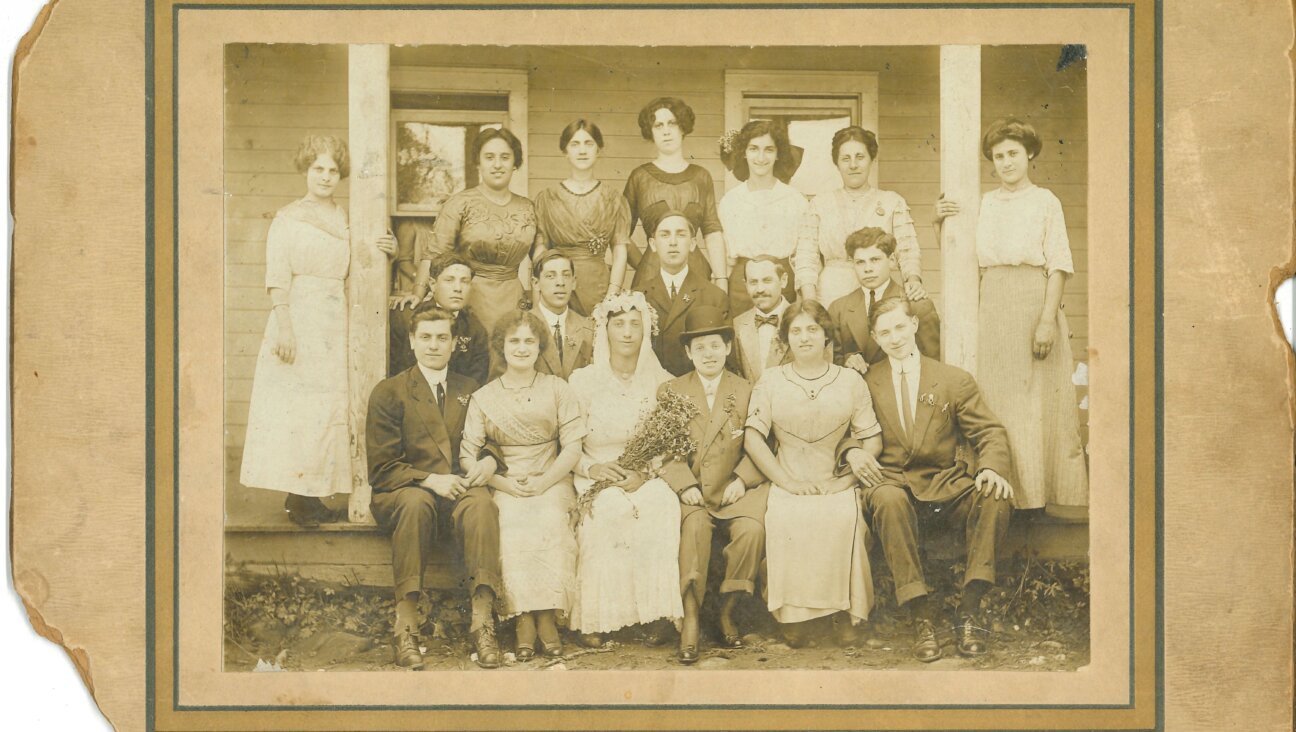Making Sense of Anti-Semitism

Image by ivan vladimirov, ‘pogrom of wine shop,’ 1919

Ugly Convenience: Russian soldiers raid a Jewish-owned wine store. Image by ivan vladimirov, 'pogrom of wine shop,' 1919
A Convenient Hatred: The History of Antisemitism
By Phyllis Goldstein
Facing History and Ourselves, 432 pages, $17.95
Historian Victor Tcherikover used to say that there are few things that have a history of 2,000 years. Anti-Semitism is one of them. And indeed, in our own day, the taxonomy of anti-Semitism yet includes religious and secular varieties, political and cultural varieties, theological and ideological varieties. The antisemitism of the right still blames the Jews for modernity (I take this as a compliment!); the anti-Semitism of the left, seeking shelter, most recently, in anti-globalization, still trots out old New Left dogmas about capitalism. And anti-Zionism is the most dangerous, since it denies the legitimacy of a normal life for Jews.
All this has been well rehearsed over the years; indeed, I am told that there are more than 1,000 books on anti-Semitism. Do we need another book on the topic?
The fact is, even with all the books out there, the global history of anti-Semitism has not been sufficiently reported. There is, of course, the classic four-volume work “The History of Anti-Semitism” by Léon Poliakov, wonderfully idiosyncratic, but woefully dated. There is Walter Laqueur’s splendid short book, “The Changing Face of Antisemitism: From Ancient Times to the Present Day.” And there is Robert Wistrich’s early excellent work, “Antisemitism: The Longest Hatred,” crafted for the general audience. There is my “A Dark Side of History: Antisemitism Through the Ages,” which sets a historical context for understanding anti-Semitism. But there has long been a need for a truly comprehensive, detailed and analytical narrative tracking the often complex history of anti-Semitism and, more important, contextualizing that history in a coherent manner.
In “A Convenient Hatred: The History of Antisemitism,” educator Phyllis Goldstein offers much valuable detail, and what Goldstein says, she says very well indeed. The book is, for a one-volume work, unusually comprehensive; the chapters are of ideal length for classroom use and, even with facts flying off the page, the writing is unusually clear. The many maps — almost always missing in histories of anti-Semitism — are of inestimable value in helping to set a historical context for the subject. Lest we forget, the history of anti-Semitism is, after all, about history. And Goldstein has not forgotten this verity.
“A Convenient Hatred” gets the history mostly right — mostly right, therefore partly wrong. There are frustrating lacunae in Goldstein’s narrative. The detailed discussion of what led to the anti-Jewish riots in first-century Alexandria is fascinating; the missing crucial point is that the event was the first pogrom in history. Goldstein’s retelling of the First Crusade is fuzzy, both in the crusade’s origins (the Byzantine ruler of Jerusalem wanted the pope to send him a few hundred soldiers to protect pilgrims; what he got — oops! — was the crusade) and in its nuanced implications. Many bishops and princes in Europe in fact made every effort to protect their Jews, not an insignificant historical matter. The blood libel is covered by Goldstein, and covered well. But the parallel libel — the libel of the desecration of the Host — arguably at least as important in the history of anti-Semitism, reads as a mere footnote.
And where is Antiochus IV and Hanukkah? Was Antiochus an “anti-Semite”? Was he not? My own view is that Antiochus was responding to geopolitical tensions with Ptolemaic Egypt and with Rome and could not afford to have civil strife in Judaea, and the villains of the Hanukkah story were the Jewish hellenizers in Jerusalem. But the story is completely missing from “A Convenient Hatred,” and missing with it is a valuable case study of what is anti-Semitism and what is not.
Finally, what of the United States? I searched in vain for a chapter on America; I found one page about Henry Ford, and that was a mere vehicle for discussing “The Protocols of the Learned Elders of Zion,” beloved by Ford. A discussion of the United States is essential for the student, if for no other reason than exploring the impact of pluralism and American particularism on anti-Semitism. The question is not why there was anti-Semitism in America, but why there was so little. Why has anti-Semitism not taken firm root in this country? In a book as comprehensive as “A Convenient Hatred,” the lack of a chapter on the United States is a grievous omission indeed.
Additionally, there is the matter of the forest and the trees. Lost in Goldstein’s estimable collection of historical data is a framework: There were three discrete periods in the history of anti-Semitism: ancient anti-Semitism, which was cultural and political; Christian anti-Semitism, 2,000 years long, which was religious and which established many of the patterns of anti-Judaism, and modern anti-Semitism, which was racial. Much of the history of this prejudice — from anti-Judaism to anti-Semitism — will make sense if the student has this basic framework.
Goldstein’s perorative chapter is not on point with the body of her book. For one thing, her analysis of contemporary European anti-Semitism is off-kilter. It appears that Goldstein is reacting to the severe expressions of anti-Semitism in 2002 and in the first half of 2004, and not to contemporary realities. The author gets carried away in maintaining that new nationalist expressions in Europe are leading to a major resurgence in anti-Semitism. Perhaps, but most often it is the opposite that is the case: It is a post-nationalist vogue, particularly among intellectuals and academics, that fuels much anti-Zionist (and by extension, anti-Semitic) activity. The question for analysts is that of the seriousness of these manifestations.
And, half a chapter on Holocaust denial? While this arena is a most sensitive one, especially in the community of Holocaust survivors, Holocaust “revisionism” is nowhere near the top of the anti-Semitism hierarchy and is not deserving of so much ink.
“A Convenient Hatred” is a book by an educator and will be used by educators. Among Goldstein’s goals is “understanding the impact of antisemitism on our own identities.” But missing from this book (as well as from many recent discussions) is the central point with respect to anti-Semitism: Anti-Semitism is not a Jewish problem; it is a non-Jewish problem. We monitor anti-Semitism, we measure it, we study its history; but at bottom, there is precious little that we Jews can do about anti-Semitism. Our best counteraction is the reaffirmation of the positive reasons for being Jewish. Leon Wieseltier makes the point well: “The analysis of antisemitism must take place somewhere between the indifferent and the hysterical.”
The biggest danger with respect to writing histories of anti-Semitism is an internal danger. It was never true that adversity was what held Jews together, that anti-Semitism was what kept Jews “Jewish.” This fallacy has a long history. In our tormented history, we Jews did not instill our torments at the heart of our identity. We were never reduced by our suffering; we were sustained, not by our morbidity, but by our vitality.
Jerome A. Chanes, a Forward contributing editor, is the author of “Antisemitism: A Reference Handbook” (ABC-CLIO, 2004).
The Forward is free to read, but it isn’t free to produce

I hope you appreciated this article. Before you go, I’d like to ask you to please support the Forward.
Now more than ever, American Jews need independent news they can trust, with reporting driven by truth, not ideology. We serve you, not any ideological agenda.
At a time when other newsrooms are closing or cutting back, the Forward has removed its paywall and invested additional resources to report on the ground from Israel and around the U.S. on the impact of the war, rising antisemitism and polarized discourse.
This is a great time to support independent Jewish journalism you rely on. Make a gift today!
— Rachel Fishman Feddersen, Publisher and CEO
Support our mission to tell the Jewish story fully and fairly.
Most Popular
- 1

Fast Forward Ye debuts ‘Heil Hitler’ music video that includes a sample of a Hitler speech
- 2

Opinion It looks like Israel totally underestimated Trump
- 3

Culture Cardinals are Catholic, not Jewish — so why do they all wear yarmulkes?
- 4

Fast Forward Student suspended for ‘F— the Jews’ video defends himself on antisemitic podcast
In Case You Missed It
-

Culture Should Diaspora Jews be buried in Israel? A rabbi responds
-

Fast Forward In first Sunday address, Pope Leo XIV calls for ceasefire in Gaza, release of hostages
-

Fast Forward Huckabee denies rift between Netanyahu and Trump as US actions in Middle East appear to leave out Israel
-

Fast Forward Federal security grants to synagogues are resuming after two-month Trump freeze
-
Shop the Forward Store
100% of profits support our journalism
Republish This Story
Please read before republishing
We’re happy to make this story available to republish for free, unless it originated with JTA, Haaretz or another publication (as indicated on the article) and as long as you follow our guidelines.
You must comply with the following:
- Credit the Forward
- Retain our pixel
- Preserve our canonical link in Google search
- Add a noindex tag in Google search
See our full guidelines for more information, and this guide for detail about canonical URLs.
To republish, copy the HTML by clicking on the yellow button to the right; it includes our tracking pixel, all paragraph styles and hyperlinks, the author byline and credit to the Forward. It does not include images; to avoid copyright violations, you must add them manually, following our guidelines. Please email us at [email protected], subject line “republish,” with any questions or to let us know what stories you’re picking up.















